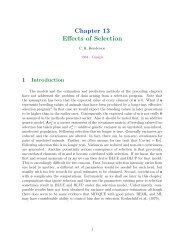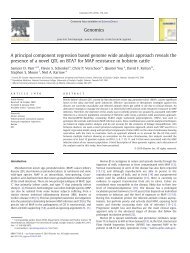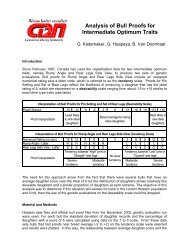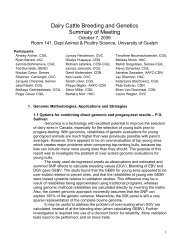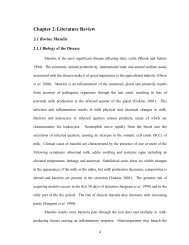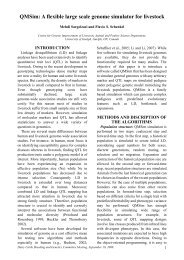Test-day fat to protein ratio as an indicator trait for sub-clinical ...
Test-day fat to protein ratio as an indicator trait for sub-clinical ...
Test-day fat to protein ratio as an indicator trait for sub-clinical ...
You also want an ePaper? Increase the reach of your titles
YUMPU automatically turns print PDFs into web optimized ePapers that Google loves.
Proportion of TD records from cows infected with putative, <strong>sub</strong>-<strong>clinical</strong> m<strong>as</strong>titis<br />
w<strong>as</strong> 0.66 in DIM from 5 <strong>to</strong> 15 (Figure 4), decre<strong>as</strong>ing <strong>to</strong> 0.19 in DIM from 36 <strong>to</strong> 45 <strong>an</strong>d<br />
staying relatively const<strong>an</strong>t at this level, dropping <strong>to</strong> 0.13 at the end of lactation (Figure 4).<br />
Posterior st<strong>an</strong>dard deviations <strong>for</strong> mixing proportions were 0.02 <strong>for</strong> the first DIM interval<br />
<strong>an</strong>d around 0.01 <strong>for</strong> the remaining intervals.<br />
Average differences between IM+ <strong>an</strong>d IM- groups <strong>an</strong>d estimates of residual<br />
vari<strong>an</strong>ces by DIM interval are in Figures 5 – 7 <strong>for</strong> milk, F:P <strong>an</strong>d SCS, respectively. Cows<br />
infected with m<strong>as</strong>titis were characterized by smaller daily milk yield (up <strong>to</strong> 5 kg on DIM<br />
from 5 <strong>to</strong> 15), larger F:P (up <strong>to</strong> 0.13 on DIM from 26 <strong>to</strong> 35) <strong>an</strong>d larger SCS (up <strong>to</strong> 1.3 on<br />
DIM from 16 <strong>to</strong> 25). Differences between me<strong>an</strong> values <strong>for</strong> mixture distributions were<br />
relatively uni<strong>for</strong>m in DIM intervals <strong>for</strong> milk <strong>an</strong>d SCS. The effect of putative m<strong>as</strong>titis on<br />
F:P different parts of lactation followed, in general, the shape of lactation curve <strong>for</strong> milk<br />
yield.<br />
Estimates of residual vari<strong>an</strong>ces differed <strong>sub</strong>st<strong>an</strong>tially between mixture<br />
components <strong>for</strong> all <strong>trait</strong>s (Figures 5 – 7). Residual vari<strong>an</strong>ces <strong>for</strong> records from healthy<br />
cows were smaller <strong>an</strong>d more uni<strong>for</strong>m across lactation th<strong>an</strong> corresponding values <strong>for</strong><br />
m<strong>as</strong>titic cows. General shapes of the vari<strong>an</strong>ce curves <strong>for</strong> IM+ categories were similar <strong>to</strong><br />
lactation curves <strong>for</strong> milk yield. Residual correlations between F:P <strong>an</strong>d SCS in IM-<br />
category were all positive <strong>an</strong>d small (250) w<strong>as</strong><br />
characterized by slightly negative genetic correlations between F:P <strong>an</strong>d SCS. Daily<br />
correlations <strong>for</strong> the PE effect among <strong>trait</strong>s were small <strong>an</strong>d mostly negative (Figure 11).<br />
Milk <strong>an</strong>d F:P were slightly positively correlated at the beginning of lactation (DIM





